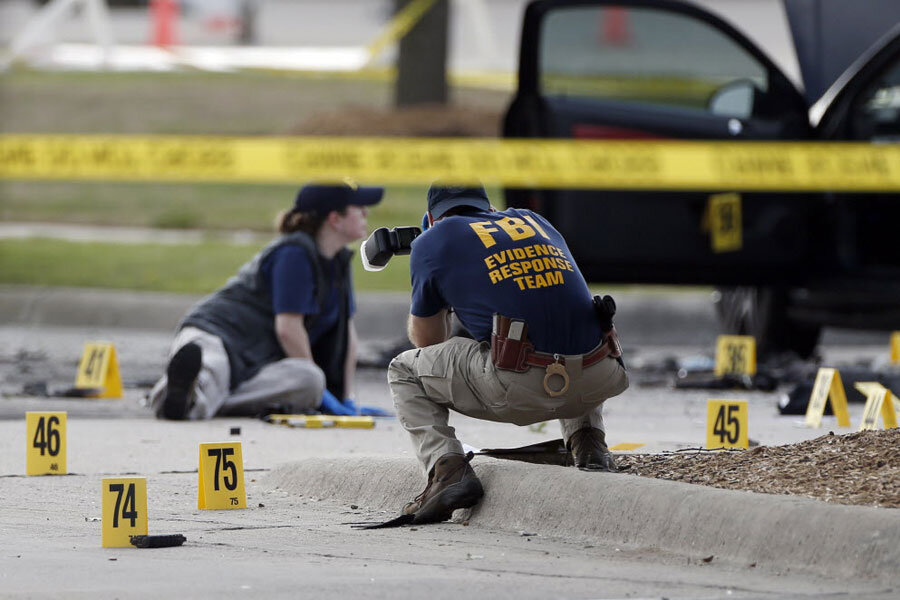What 'Draw Muhammad' shootings say about Islamic State reach
Loading...
The attempted terror attack by two Muslim-Americans in Garland, Texas, Sunday so far appears to confirm what terrorism experts have been saying for months: The Islamic State has no ability to carry out attacks in the United States.
But the incident shows that the Islamic State’s ability to inspire and, to a limited degree, direct “lone wolf” jihadis remains a challenge with no simple answers.
No evidence yet shared with the public suggests that the two men killed by a security officer when they opened fire on a building hosting a “Draw Muhammad” contest were hardened Islamic State operatives. They pledged fealty to the Islamic State in a tweet minutes before the attack.
But one of them, Elton Simpson, had been on the Federal Bureau of Investigation’s radar screen since 2006, and he faced charges in 2011 over claims that he wanted to join jihad in Somalia.
The degree to which he and his Phoenix-area roommate, Nadir Soofi, reached out to the Islamic State – or the Islamic State (also known as ISIS) reached out to them – is unclear. The FBI is combing through the men’s social media histories for clues.
But it is becoming increasingly clear that the Islamic State’s greatest threat to the US is in its online messaging, which Jessica Stern, co-author of the new book “ISIS: The State of Terror,” calls a “social contagion.” What is known about Sunday’s attack underscores that “it’s less important that ISIS actually speaks [directly to attackers], because ISIS’s goal is to inspire this kind of attack.”
This is terrorism on the cheap. The Islamic State doesn’t have to try to send operatives to the US. It can simply prod disgruntled Americans and claim the credit.
For the Islamic State, “trying to get guys from Syria or Iraq into the United States [to fight] would be stupid and fruitless, because it would take time and money, it would take guys away from the fight, and why would you even do it when you have a great force multiplier in the Internet, where you can get people to pop up anywhere, making you seem omnipotent and universal?” asks Tim Clemente, a former FBI counterterrorism agent.
On one hand, Sunday’s attack gave that impression. But it also suggested the limitations of outsourcing terrorism operations. America’s legal dockets are strewn with the stories of homegrown terrorists who were rumbled by the FBI or simply failed. CNN notes that the attackers had body armor and semiautomatic weapons and yet were killed by a traffic officer with a pistol.
The events showed that the attackers were “wannabes who have never really done anything legitimate, and who hope this act will give them acceptance,” Mr. Clemente says.
For that reason, the attack in Garland “doesn’t suggest to me that this is a clear escalation,” says Ms. Stern. Rather, it points to the Islamic State’s opportunism – both in recruiting would-be terrorists and in capitalizing on their exploits.
“This is something ISIS has been hoping will happen,” she says.
The Islamic State has made many claims of responsibility in attacks throughout North Africa and Europe, though this is the first time it has done so for an attack in North America.
The attack last October on the Canadian Parliament in Ottawa by a lone gunman seemed taken out of the Islamic State playbook, investigators said, but Canadian intelligence never found a credible connection.
The Garland attack also stirred memories of the attack by jihadists on the satirical Paris magazine Charlie Hebdo, as well as an attack at an event this spring attended by Lars Vilks, a Swedish cartoonist who has caricatured Muhammad.
Sunday’s event, sponsored by controversial free-speech activist Pam Geller, promised the artist behind the best cartoon of Mohammad a $10,000 prize. It included a keynote address from controversial Dutch politician Geert Wilders, who has decried the “Islamicization of the Netherlands.”
The Islamic State message does appear to hold some appeal for a minuscule fringe. In addition to Islamic State-inspired attacks, an estimated 3,000 Westerners – including perhaps “hundreds” of Americans – have traveled to Syria since 2011 to join violent jihad.
As of last October, Norwegian terrorism analyst Thomas Hegghammer found a low “blowback rate” for those fighters coming back to their home countries to engage in terrorism – only about 1 of every 150 to 300, much lower than the rate for foreign fighters in Afghanistan, for example.
He suggested that was because of the Islamic State’s primary focus on establishing a caliphate in the Middle East. “ISIS is unlikely to go all in on global [terrorism] operations the way al Qaeda Central has. The organization is not designed for that, and such a strategy is not compatible with its state-building ambitions,” he wrote on CNN.
In the months since, ISIS’s messaging campaign has become more global, but its operational reach has apparently remained focused on the Middle East. The result, experts say, is attacks like the one Sunday.
“It’s not as if ISIS has a cell in the United States or trains people,” Aymenn Jawad al-Tamimi, an Islamic State expert at the Interdisciplinary Center in Harzliya, Israel, tells The New York Times. “This is not ISIS coming to America.”









